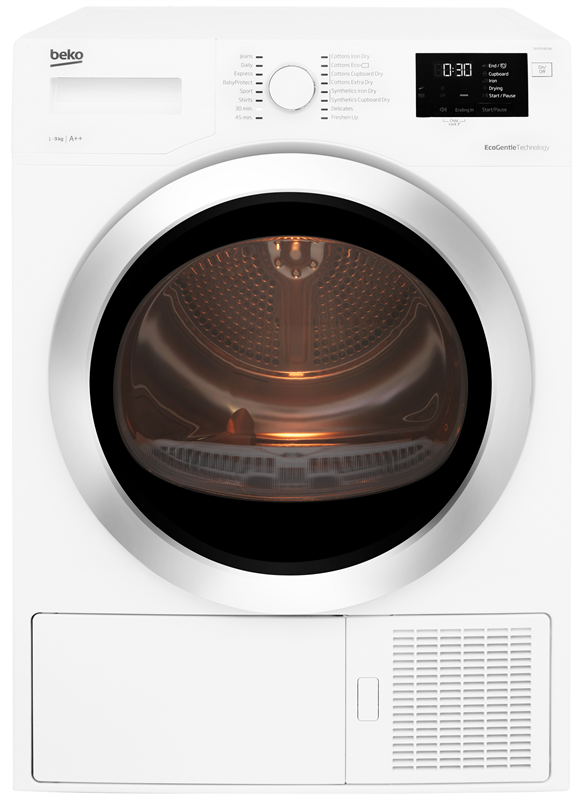We’ve gone a long way since the days of washboards and drying clothing on clothes lines, even though doing laundry may be the bane of your existence.
Particularly when it comes to the power of drying technology, our laundry machines continue to advance and perform their magic. The heat pump dryer is one of the most inspirational advancements in the world of laundry equipment right now. It is the most energy-efficient dryer available, dramatically lowering your carbon footprint while also saving you money.
These heat pump dryers consume 20–60% less energy than standard dryers, making them highly eco-friendly. Sounds good, doesn’t it?
What is a heat pump dryer for clothes?
First of all, it’s critical to emphasize that these electric dryers are ventless, which allows for flexible placement as they don’t need good access to exterior ventilation. This has two major advantages:
1. If you don’t have much space, you can install this dryer next to anything or in any room, such as your closet, bathroom, or bedroom. Because of reason number 2, nothing is off bounds.
2. A venting duct is not required to be installed.
The heat pump clothes drier operates without vents by drawing moisture from the garments and storing it in a detachable container.
The hot air is captured within the heat pump dryer using refrigerant, which is then used to push it through a compressor, where it will finally become even hotter than before. The dryer drum then allows the hot air to enter once more, starting the cycle all over again. Depending on the size of your dryer, the moisture from the wet garments is then collected in the built-in catch drawer, where it can either stay for a few cycles or go through a hose and out a drain.
What Sets a Heat Pump Model Apart from a Regular Dryer?
A heat pump model and a standard dryer have significant distinctions.
A heat pump dryer, for instance, uses the air from the room to heat the air inside the dryer, which is more energy-efficient than a regular dryer, which typically distributes heat through a heating element.
Their venting mechanisms are a key distinction between the two types of dryers. All dryers, with the exception of heat pump dryers, require a vent to remove moisture, as we previously indicated.
Since this environmentally friendly dryer has no vents, the moisture that is extracted from the wet clothes must go somewhere. Fortunately, it does so right into a compartment that is easily accessible, allowing you to remove it and pour it into the sink, over your plants, or another location where it can be recycled. With more control over where your water travels thanks to heat pump dryers, there are more opportunities for reuse and less waste.
Technology comparison
We’ve produced a guide with the advantages and disadvantages of a heat pump, electric, and gas dryer to assist you compare each technology and choose which would be ideal for your lifestyle, even though all of our dryers have their benefits.
Heat-pump-powered dryer
Positives: Cost-effective, easy to install, saves money over time, and lasts up to 20 years.
Cons: Longer drying time, higher initial cost
Dryer electric
Pros: Simple installation; lower initial cost
Cons: Expensive over time and inefficient in terms of energy
Fuel dryer
Faster drying cycles, reduced energy consumption
Cons—Needs a gas connection
Features of a Heat Pump Dryer
Putting jeans in front-load dryer
Heat pump dryers are not only advantageous for the environment; they also work incredibly well at drying clothes.
The ideal illustration showing that heat pump technology is just as effective as standard electric or gas dryers is this Beko ventless pump dryer. Here are some characteristics of this particular brand:
With the aid of this feature, you can properly take care of your delicate.
Pants Cycle—Select this to always achieve an even dry on those dense jeans, which are infamous for taking a while to dry.
Anti-Wrinkle—With the help of this useful little feature, you can avoid ironing totally and receive clothes free of wrinkles.
Stainless Steel Drum—This model’s stainless steel drum operates more quietly and is incredibly durable. It also won’t rust, discolor, or corrode.
Styles of Heat Pump Dryers
When it comes to heat pump dryers, the inside matters more than the outside in terms of appearance.
Let’s face it, these heat pump clothes dryers look exactly like standard dryers, even though they appear to be as tidy and sleek as this Whirlpool heat pump dryer. When you’re throwing a load in, the fact that they work so hard to recycle hot air should be the only consideration.
Although vent less dryers often have a similar appearance, not all of them work the same way, so it’s important to choose one based on characteristics that complement your lifestyle in order to discover the appropriate fit.
Get a heat pump dryer with Smart Care if you are someone who is constantly on the go so you can manage your laundry loads, troubleshoot, and more all from your phone! Or perhaps you need a dryer setting that can manage the bulk and fluff of your king-size bedding. In that case, having a ventless dryer with a Bulky Bedding Cycle will definitely solve the problem.
Whatever model you choose, make sure it includes functions that improve your life.
Read More: click









